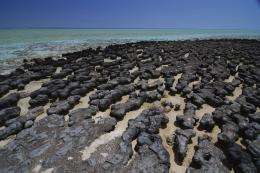Modern stromatolites at Shark Bay, WA
(PhysOrg.com) -- Bacteria that produce oxygen may have evolved hundreds of millions of years earlier than previously thought, a new study into ancient rock formations in Western Australia suggests.
Well-preserved fossils of stromatolites in the Tumbiana Formation, in the Pilbara region, have been dated as 2.72 billion years old, more than 270 million years older than the previous oldest evidence of oxygenic photosynthesis, UNSW doctoral student David Flannery has told a symposium in Perth.
Flannery and other researchers from UNSW's Australian Centre for Astrobiology (ACA) and Macquarie University presented their findings at the Fifth International Archean Symposium, in a paper titled "Does the Neoarchaean Fortescue group record the earliest evidence for oxygenic photosynthesis?"
They note that most scientists accept that Earth's atmosphere became oxygenated - and thus habitable for other forms of life - during a period known as the Great Oxidation Event around 2.45 and 2.32 billion years ago. Blue-green algae, or cyanobacteria, are thought to have been the first organisms to do so, and they lived in colonies that left behind the stromatolite fossils.
But when oxygen-producing organisms first evolved and how long it took the resulting oxygenation of the atmosphere has been uncertain. The new findings may suggest the process not only started earlier but was more extended and gradual than previously thought, according to co-author Professor Malcolm Walter, director of the ACA.
"The formerly neat story of the Great Oxidation Event now seems not to be so neat after all," Professor Walter says. "The idea that the Earth's atmosphere suddenly became oxygenated about 2.45 billion years ago now seems too simple."
He cautions that the new study is still in its early stages, relying on fossilised rock structures and chemical evidence rather than definitive cellular structures: "It's early days yet and what we have found is not unequivocal evidence, but stromatolites are very distinctive and these structures are identical with those of living stromatolites we're studying at Shark Bay, in Western Australia. I'm confident enough in what we've found."
Provided by University of New South Wales























